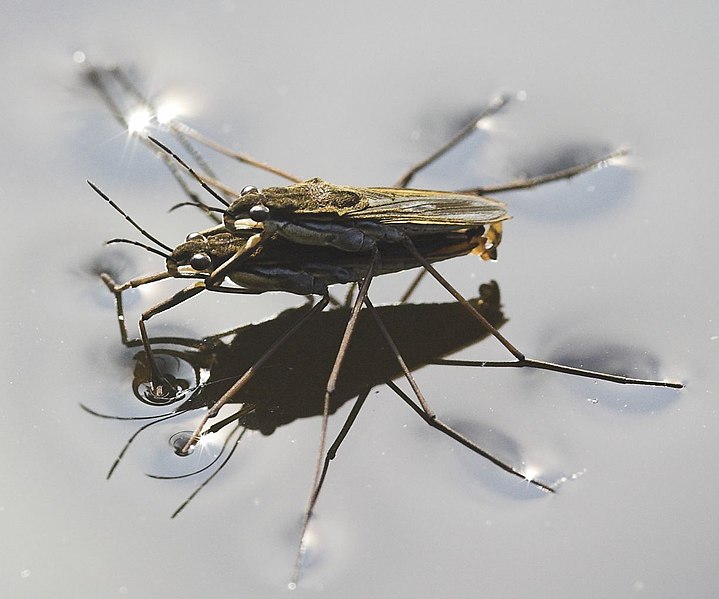

| Visitors Now: | |
| Total Visits: | |
| Total Stories: |

| Story Views | |
| Now: | |
| Last Hour: | |
| Last 24 Hours: | |
| Total: | |
Nature Inspires New Submarine Design
Superhydrophobicity is one of most important interfacial properties between solids and liquids. SHI Yanlong and his group from the College of Chemistry and Chemical Engineering, Key laboratory of Hexi Corridor Resources Utilization of Gansu Universities, Hexi University investigated the superhydrophobicity of the water boatman’s hind wings. The study showed that superhydrophobicity plays a crucial role in the water boatman’s swimming, balance, and breathing in water, and in its escape ability from water area under unfavorable conditions. Their work, entitled “Investigation of superhydrophobicity on water boatman’s hind wings”, was published in the Chinese Science Bulletin2012, Vol 57 (14).

Recently, studies of superhydrophobicity have attracted much interest because of its potential practical applications. In nature, lotus leaves, water-striders’ legs, and some insects’ wings exhibit perfect superhydrophobicity. Inspired by these superhydrophobic characteristics within living organisms, scientists have invented many ways to fabricate artificial superhydrophobic materials. Superhydrophobic surfaces are commonly constructed either by creating micro/nanostructures on hydrophobic substrates or by chemically modifying micro/nanostructured surfaces with materials of low surface free energy.
Research on superhydrophobicity has seldom focused on insects that live in water. In this report, the authors investigated the water-dwelling water boatman, which belongs to the Corixidae family of the order Hemiptera, suborder Heteroptera. The water boatman can swim freely and breathe in water. The study showed that the superhydrophobicity of the water boatman’s hind wings plays a crucial role in its swimming, breathing, and balance, as well as its ability to escape from the water surface under unfavorable conditions.

The water boatman’s metapodia are quant-like and keep swinging while it swims; counterforces between the metapodia and water push the water boatman forward or downward. When the metapodia stop swinging, its body begins to float upward because of the buoyancy induced by the perfect superhydrophobicity of the water boatman’s hind wings.
Superhydrophobic surfaces are usually induced because of the synergistic effects of hierarchical micro/nanoscale binary structures and low surface free energy. Scanning-electron microscopy studies of the micro/nanoscale structure revealed that the surface of the water boatman’s hind wings is composed of mastoids and nanorods with diameters of about 80nm and 50-100nm, with typical mastoid-to-mastoid and rod-to-rod distances of about 50-200nm and 300-1000nm, respectively. Moreover, the insect’s wing surface contains low surface energy protein, lipid, and chitin materials, which are hydrophobic. The superhydrophobicity of the water boatman’s hind wings is presumed to originate from the combination of such a hierarchical surface structure together with hydrophobic materials contained on the wing. Water contact angles on the wing surface were measured to be 159° and the glide angle was about 8°.
According to Cassie’s theory, contact between water droplets and the water boatman’s hind wings is a composite contact of solid-liquid-gas. On the rough hierarchical surface, air can be trapped within the micro/nanoscale structures on the wing surface, which makes it difficult for water to enter into the structures to fully wet the surface. The overall contact area between water droplets and air trapped within the micro/nanoscale structures can be roughly estimated to be about 9% (the corresponding contact area between water drops and solid wing surface is about 91%).
The superhydrophobicity of the water boatman’s hind wings enables it to swim freely, breathe in water with the assistance of air trapped on its hind wings’ surfaces, and escape easily from water area under unfavorable conditions without being affected by moisture.
This research may provide a new strategy for submarine design and the fabrication of a water boatman robot which could swim in water and walk on water surface. Water boatman robots with strong wave resistance and high walking stability on water could be outfitted with miniature biochemical sensors , the biomimetic boatman robots may be used to monitor chemicals at water area for environmental monitoring and cleaning applications, and can be teleoperated or controlled autonomously.
Contacts and sources:
Shi Yanlong
Science in China Press
Citation: Wang Y S, Shi Y L, Feng X J, et al. Investigation of superhydrophobicity on water boatman’s hind wings (in Chinese). Chin Sci Bull (ChinVer), 2012,57:1227-1230, doi: 10.1360/972011-2636.
Read more at Nano Patents and Innovations
Source:


